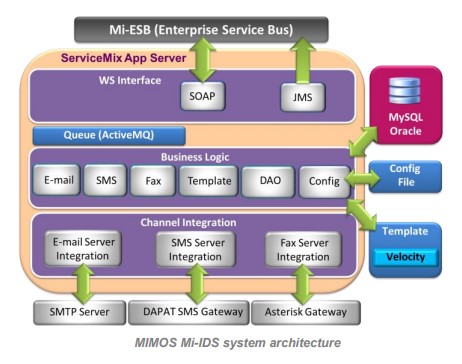Overview
In digital information, accessible electronic communication must be delivered to multiple receivers via an efficient and reliable system. MIMOS Mi-IDS is a component that provides multiple channel information dissemination services. It allows enterprise applications to send out messages through e-mail, SMS or fax with predefined templates and data.
MIMOS Mi-IDS is a component that disseminates information to recipients through multiple messaging channels. This component receives requests from a web service client, and renders the information from a database or client input parameter. The information is then mapped with an e-mail/SMS/fax template to
generate message, and finally the message is disseminated to a target recipient through e-mail or SMS or fax channels.
Technology Summary
Mi-IDS
A component that provides multiple-channel information dissemination services.
Industries: Enterprise, Governmen
Features
- E-mail, SMS and fax modules
- Web service support
- Supplementary web services
Technology Benefits
- Multiple channel distribution
- Static and dynamic merging
- Asynchronous messaging
Mi-IDS comprises the following features:
Features
Mi-IDS comprises the following features:
- E-mail, SMS and Fax Modules
Mi-IDS consists of three modules: E-mail, SMS and Fax. Via web services, Mi-IDS will check for suitable content to send out via any of these modules based on input parameters and configuration settings. - Web Service Support
Three types of web services that are consumed by the web service client are available, namely batch type, free type and real-time type map/merge. - Supplementary Web Services
Supplementary web services are available. For e-mail, attachments can also be sent with e-mail. For batch services, an asynchronous service allows a unique response token to be sent immediately to the web service client.
Technology Benefits
The main impacts of Mi-IDS are:
- Multiple Channel Distribution
Mi-IDS is a centralised component that allows applications to distribute messages to users via multiple channels such as email, SMS and fax. - Static and Dynamic Merging
There is an option to merge a message’s static template and an application’s dynamic contents to produce a final output message. - Asynchronous Messaging
In Mi-IDS, an application can send out batch messages through the message channels asynchronously. This provides flexibility as it allows the request client to process other tasks without waiting for a reply from Mi-IDS.






